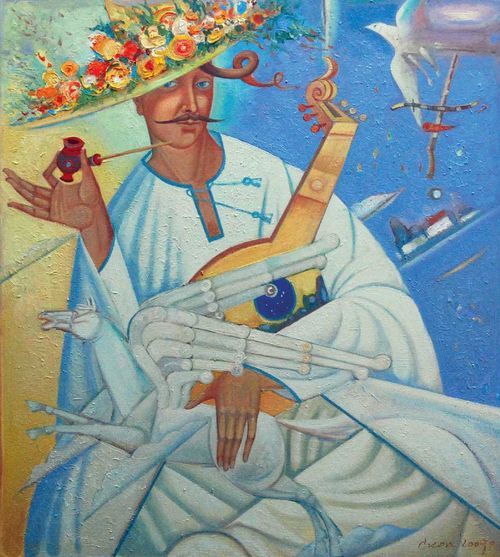Cossack Mamai and NKVD-shot kobza players
Mykhailo Hrushevsky Museum launches Orest Skop’s art album
Ukrainian folk paintings with a Cossack sitting cross-legged and playing the kobza lute-like musical instrument have become the symbol of Ukrainian soul and our national culture. Researchers are still divided on the origin of this image. Some scholars insist the Cossack’s prototype was actually the Golden Horde military leader, Mamai, who lost the Battle of Kulikovo back in 1380. Mamai could also have been used as a general rather than proper name. At one time people who preferred to live like nomads in the Ukrainian steppe were referred to as Mamais. The appellation was also applied to the stone statues (some of which are still there). With time, the appellation became synonymous with such notions as Cossacks, Haidamaky, and rozbyshaky – generally meaning bandits. Cossack Mamai implies lots of creative interpretations, including art, music, and movies. There is a good example: Lviv artist Orest Skop’s project currently on display at Kyiv’s Mykhailo Hrushevsky Art Museum.. The man has worked on a series of Mamai paintings, starting in the 1980s. Each of his paintings (300 in all) is in memory of a kobza-player who was murdered by the NKVD back in 1934.
Orest Skop launched his Art Album Cossack Mamai at the Hrushevsky Museum not so long ago. One can trace the artist’s dynamics in treating the legendary key image.
Orest Skop: “I’d love to have all reproductions in a single edition, but that proved easier said than done. I have old faded photos of some of my early works. I hope that the second volume of my album will come off the presses, including all of my 300 paintings. This publication will also include explanations, considering that each picture has a special meaning.”
Orest Skop dedicates his current album to Taras Shevchenko’s 200th anniversary (considering that Shevchenko mentions Cossack Mamai in his verse). The album boasts architectural designs, including the one of the Ivan Franko Museum in Nahuievychi, those of Solomia Krushelnytska and Mykhailo Hrushevsky museums in Lviv, Ternopil Local History Museum, a number of Markiian Shashkevych museums, etc.
Mykola ZHULYNSKY, director, Taras Shevchenko Institute of Literature under the aegis of the National Academy of Sciences of Ukraine: “Each of his Cossack Mamai paintings is a significant event in our art history, in terms of architectonics, ideological and thematic focus. I can’t stop wondering about Orest’s creative imagining. Cossack Mamai in his pictures is always different while retaining his traditional character and background: his smoking pipe, his horse, saber, and so on. In each painting these components appear to be playing a different role, creating a harmonious composition. Orest uses Ukrainian baroque techniques in his own unique manner. I believe that, by portraying Cossack Mamai, he has succeeded in conveying his image of Ukraine. He is a true national artist. Orest Skop’s Cossack Mamai is a case study in adding an unmatched, incredibly creatively enriching touch to a classical theme, owing to his singular talent.”
Taras KOMPANICHENKO, artistic director, Khoreia Kozatska Ensemble: “I hold Orest Skop in esteem. When I was a first-year student of the Lviv Art Academy, tasked with analyzing ongoing Lviv art exhibits, I’d often see Skop’s paintings. Each was a mind-boggling revelation to me. I could not believe what I saw; the man could keep his own singular visage in the general European context.”






